The Oa peninsula
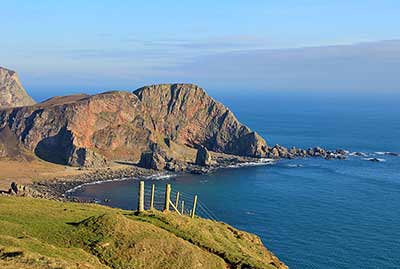
Port Ellen is dominated to the south by the Oa peninsula. This is almost an island in its own right and is nearly cut off from Islay by several streams following both ways from Kintra. The Oa rises steadily from sea level at Kilnaughton chapel and graveyard to 202 metres at Beinn Mhor, its most southerly point.
A few miles to the west is the American Memorial (the monument) on the Mull of Oa, at 131 metres high. There are several lochs on the Oa; Loch Kinnabus in the south is the largest, followed by Loch Ard-Achadh a few hundred metres to the north-east. You can find two other lochs in the west at Lower Glen Astle.
Most of the shoreline is cliffs. Many are virtually sheer, but there are a few sandy bays. The first is on the Port Ellen side at Kilnaughton; then further on past the lighthouse you’ll find the Singing Sands, with Kintra beach and the Big Strand on the Loch Indaal side.
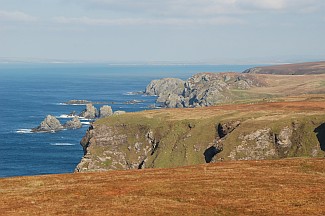
At the end at Lower Killeyan is an attractive sheltered sandy beach, with a large cave frequently used by campers. The only disadvantages to this beach are that it is a good walk from the main road, it’s not particularly good for swimming as there is a lot of seaweed and a chance of dangerous currents. However, it’s very tranquil and a great spot to observe coastal wildlife.
Until recently the only occupation on the Oa was farming, but forestry now extends almost to Port Ellen. Dominated by rocky outcrops and blanket peat, the landscape is undoubtedly very bleak, particularly during winter. However, a fertile strip stretches through the centre following the limestone bedrock. This produces the green fields that keep the farming enterprises viable. Some forestry is being cleared for crofts, affordable housing and native flora.
Clearances
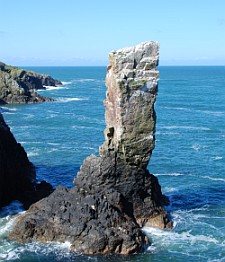
Before the clearances, the peak population of the Oa was around 800. Look carefully and you can find many ruined houses and particularly two abandoned villages. One (Lurabus) is on the hillside at the opposite side of Port Ellen Bay, while Sruthan Poll Nan Gamhna (or Chrasdail) is in a very remote area on the Loch Indaal side beyond Kintra.
Opposite Chrasdail on the other side of the glen are ruins of another settlement called Tockmal. You can find a cup-and-ring marked stone, a standing stone (part of a burial site) and the ruins of a chapel here.
At the end of the burn, which flows through the glen towards the sea, is a huge stack called Soldiers Rock in an area of outstanding natural beauty. At Risabus, in the heart of the Oa, you’ll discover the remains of the former Oa Church, built by Thomas Telford in 1828.
Cragabus Chambered Cairn
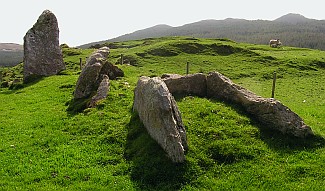
There’s a chambered cairn at Cragabus. The chamber and part of the facade comprise virtually all that now remains of this chambered cairn, which is situated 60 metres SW of Lower Cragabus at the NW end of a rocky knoll known as Creag Mhor.
The conspicuous standing stone about three metres east of the chamber is just over two metres high. It’s probably the survivor of a pair of portals, which would mean that the chamber was originally nearly eight metres long, with four or five compartments.
American Monument
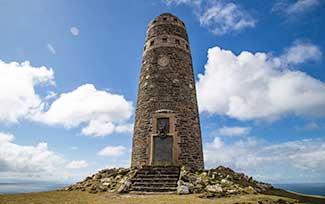
Don’t miss the American Monument, built in 1920 to commemorate the huge loss of life when two troop ships sank in Islay’s waters in the last year of World War I.
The walk from the car park to the monument and the view from the cliffs are very rewarding and highly recommended.
RSPB Oa Nature Reserve

The area around the monument is a designated RSPB nature reserve with plenty of wildlife throughout the year. The reserve is particularly important for rare birds such as chough and golden eagles. In spring corncrakes return from Southern Africa to nest in the Oa’s nettle patches and iris beds. Sea birds such as fulmars, kittiwakes and razorbills nest on the steep cliff-faces during the summer, and otters can often be seen along the tide line. The coastal heath is a valuable habitat for many insects including the marsh fritillary butterfly.
You can walk from the car park over the steep cliffs to the American Monument. There are good signposts and dramatic views of the coastal scenery.
In 2007, the west side of the Oa was designated a Special Protection Area (SPA) for the protection of chough and covers the coast at Kintra to Ineraval in the south-east, a total area of more than 1930 hectares. An SPA enforces strict guidelines in accordance with the EC directive on the conservation of wild birds.